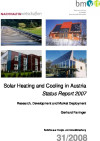Publications
There are 379 results.
Solar Heating And Cooling in Austria (Faninger, 2009)

Status Report 2009 on Research, Development and Market Deployment of Solar Thermal Technologies in Austria. Presented to the IEA Solar Heating and Cooling Programme in July 2009
IEA Bioenergy Task 42 Biorefineries : adding value to sustainable utilisation of biomass (2009)

This feature article provides an overview of the work of Task 42: Biorefineries: Co-Production of Fuels, Chemicals, Power and Materials from Biomass. It was prepared by the Task Leaders, Mr. Ed de Jong, Avantium Technologies BC and Mr. René van Ree, Wageningen University and Research Centre, the Netherlands.
English
How much Energy Efficiency can Energy Contracting deliver to the Residential Sector in Germany? (2009)

Transaction and Life Cycle Cost Analyses, Market Survey and Statistical Potential - IAEE09 abstract
English
IEA Bioenergy Task 39 - An Examination of the Potential for Improving Carbon/Energy Balance of Bioethanol

English
Process Heat Collectors State of the Art within Task 33/IV (Weiss/Rommel 2008)

Approximately 128 GWth, the equivalent of 183 million square meters, of solar thermal collectorswere installed by the year 2006 worldwide (Weiss et al., 2008). Until now, the widespread use of solarthermal applications has focused almost exclusively on swimming pools and residential domestichot water preparation and space heating.
English
Particulate Emissions from Biomass Combustion in IEA Countries (2008)

English
Opportunity Cost Tool & Comparison and Evaluation of Financing Options for Energy-Contracting Projects (2008)

Task XVI - A manual for ESCOs, ESCO customers and ESCO project developers.1. Despcription of a methodology to compare finance options for energy service projects and 2. Opportunity Cost Tool: Estimation and Visualization of Energy Costs, Saving Potentials and Future Energy Cost Savings for the development of energy-contracting projects.
English
Potential for Solar Heat in Industrial Processes (Claudia Vannoni/Riccardo Battisti/Serena Drigo 2008)

The goal of this report, developed in the framework of the IEA Solar Heating and Cooling Programme Task33 and IEA SolarPACES Programme Task IV - Solar Heat for Industrial Processes (SHIP), is to highlightthe potential use of solar thermal (ST) plants to provide heat for industrial applications. In order to fulfil thisaim, several national potential studies were surveyed and compared with a focus on the key results and themethodologies applied.
English
Industrial Process Indicators and Heat Integration in Industries (Brunner/Slawitsch/Giannakopoulou/Schnitzer 2008)

The goal of this report, developed in the framework of the Task33/IV - Solar Heat for Industrial Processes (SHIP) of theInternational Energy Agency, is to give an overview of the toolswhich have been developed within this IEA Task 33/IV.
English
Comprehensive Refurbishment of Buildings through Energy Performance Contracting (2008)

Comprehensive Refurbishment of Buildings through Energy Performance Contracting - A Guide for Building Owners and ESCos
English
Solar Heating and Cooling in Austria

Status Report 2007
Research, Development and Market Deployment
Series
31/2008
Gerhard Faninger
Publisher: BMVIT
English, 42 pages
Publication Downloads
Performance and risks of advanced pulverised coal plant (Nalbandian, 05-2008)

Hermine Nalbandian
Publisher: IEA-CCC
English, 70 pages
Greenhouse gas emission factors for coal (Adams, 06-2008)

English
Prospects for coal and clean coal technologies in India (Mills, 12-2007)

English
Properties and behaviour of SO2 adsorbents for CFBC (Smith, 11-2007)

English
WET FERMENTATION TECHNOLOGY FOR BIO-WASTES (2007)

Bio-waste Digestion Markgrafneusiedl: The example of a successful bio-waste fermentation plant described in this contribution is operated by Bio-waste Digestion "Markgrafneusiedl". The plant with an annual capacity of 15,000 tonnes went into operation in 2006. It can process a variety of bio-waste material such as waste from the meat processing industry, separately collected bio-waste from households and even food waste contained in steel barrels of up to 200 litres.
English
Solar Heat Worldwide - Markets and Contribution to the Energy Supply 2005

The solar thermal collector capacity in operation worldwide equaled 107.8 GWth corresponding to 154 million square meters at the end of the year 2005. Of this, 90.7 GWth were accounted for by flat-plate and evacuated tube collectors and 16.2 GWth for unglazed plastic collectors. Air collector capacity was installed to an extent of 0.9 GWth.
English
